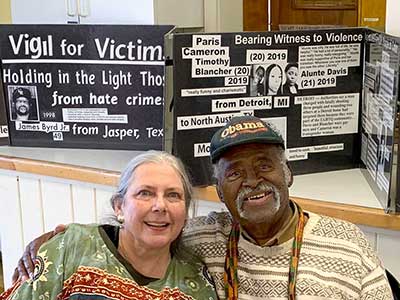by Kayla Epstein | October 2019
The cars came one by one, down a gravel road and through a cotton field, to the edge of the Tallahatchie River and the spot where, 64 years ago, historians believe Emmett Till’s lifeless body was pulled from the river. The vehicles carried Till’s relatives, including cousin the Rev. Wheeler Parker, community leaders and advocates dedicated to keeping his memory alive. The group had gathered on Saturday at noon in the remote spot near Glendora, Miss., to dedicate yet another memorial to Till. And this time, it was bulletproof. It took 50 years to get the first memorial to Till erected in Tallahatchie County, the site of the lynching that helped spark the civil rights movement. But then an entirely new battle began: keeping the tribute intact.
TAGS: [Racial Terrorism] [2010’s] [History] [Systemic Racism] [White Supremacy] [White Culture] [Social Justice] [Black Lives Matter] [White Privilege] [White Defensiveness]
by Corey Mitchell | January 2021
Searing images from this month’s mostly white insurrection in Washington, D.C.—including a hangman’s noose on the Capitol grounds and the Confederate flag carried inside the U.S. Capitol—harken back to another era when both were tools and symbols of white supremacy across the country. But relatively few students have learned about previous sordid moments that foreshadowed this year’s efforts to instill terror and violently overturn an election such as the Wilmington Insurrection of 1898, widely thought to be the only successful coup in U.S. history, and the Tulsa Race Massacre.
TAGS: [Racial Terrorism] [2020’s] [History] [Social Justice] [Systemic Racism] [White Culture] [Slavery] [Politics] [Denial] [Silencing POC] [Teachers] [White Supremacy] [White Privilege] [White Blindness] [White Defensiveness] [Black Lives Matter]
*Paywall Alert
by Gilliam Graham | February Year Unknown
In July of 1750, a short notice appeared in a Boston newspaper calling for help finding an enslaved man who had run away from Ichabod Goodwin of Berwick in the province of Maine. Pompey was described as a short man of about 40 who spoke good English, wore a homespun jacket and checked shirt and had a cut ear. Fitted around his neck was an iron slave collar, a brutal device used by enslavers to identify and discipline the people they claimed as property. Goodwin, a blacksmith who offered a reward for Pompey’s return, likely made the collar himself. Notices like these of runaway slaves are among the few written documents that describe the reality and brutality of slavery in the early days of the Massachusetts Province of Maine. Largely left out of history books or minimized as an insignificant footnote, slavery remains a nearly hidden aspect of the history of Maine, a state better known as the home of abolitionists than enslavers or profiteers. However, reminders of Maine’s slavery connections linger in the coves, streets and other landmarks named for slaveholders who have been remembered instead for their contributions to shipbuilding, trade and establishing coastal towns.
TAGS: [Racial Terrorism] [Slavery] [Systemic Racism] [White Supremacy] [White Culture] [White Privilege] [Black Lives Matter] [History] [Social Justice]
by Chuck Armstrong | February 2021
The Historical Society reports that during the colonial period of our country, 41 percent of households in New York City owned slaves, compared with 6 percent in Philly and 2 percent in Boston. “Only Charleston, South Carolina, rivaled New York in the extent to which slavery penetrated everyday life.” In a lot of ways, the life of the enslaved African in New York City looked different than in Charleston or elsewhere in the South; according to The New York African Free School, “Although New York had no sugar or rice plantations, there was plenty of backbreaking work for slaves throughout the state. Many households held only one or two slaves, which often meant arduous, lonely labor. Moreover, because of the cramped living spaces of New York City, it was extremely difficult to keep families together. It was not uncommon for owners to sell young mothers, because they did not want the noise and trouble of children in their small homes.”
TAGS: [Racial Terrorism] [2020’s] [White Supremacy] [History] [Slavery] [White Culture] [White Privilege] [Systemic Racism] [Anti-Racism] [Justice System] [Denial] [Racial Covenants] [Black Lives Matter]
by Zinn Education Project | Date Unknown
On Dec. 28, 1872, the Yavapai people’s shelter of Skeleton Cave, located in Salt River Canyon, Arizona, was attacked by Lieutenant Colonel George Crook and the 5th Cavalry. The army took up position around the mouth of Skeleton Cave. Surrounded, the Yavapai refused to surrender. The soldiers opened fire and dropped boulders on those who gathered at the mouth of the cave. Close to 100 Yavapai adults and children were massacred. This event has come to be known as the Battle of Salt River Canyon or the Skeleton Cave Massacre.
TAGS: [Racial Terrorism] [Indigenous] [History] [Systemic Racism] [White Supremacy] [White Culture]
by Emmanuel Felton | January 2021
The first glimpse of the deadly tragedy that was about to unfold came at 9 a.m. on the morning of the insurrection for one Black veteran of the US Capitol Police. But it didn’t come from his superiors — instead the officer had to rely on a screenshot from Instagram sent to him by a friend. … Management’s inaction left Black police officers especially vulnerable to a mob that had been whipped up by President Donald Trump, a man who has a record of inspiring racist vigilantes to action. One of the most defining videos of that day was of one of their colleagues, another Black officer, trying in vain to hold back the tide of rioters who had broken into the building and were hunting for Congressional members. BuzzFeed News spoke to two Black officers who described a harrowing day in which they were forced to endure racist abuse — including repeatedly being called the n-word — as they tried to do their job of protecting the Capitol building, and by extension the very functioning of American democracy. The officers said they were wrong-footed, fighting off an invading force that their managers had downplayed and not prepared them for. They had all been issued gas masks, for example, but management didn’t tell them to bring them in on the day. Capitol Police did not respond to BuzzFeed News’ request for comment about the allegations made by officers.
TAGS: [Racial Terrorism] [2020’s] [Systemic Racism] [White Supremacy] [White Culture] [White Privilege] [Politics] [Accountability] [Black Lives Matter] [Social Justice] [Policing] [-ing While Black]

















